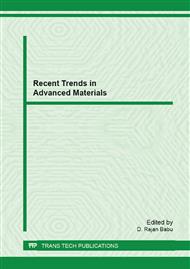[1]
Y.Yagyik, H. Lal, I.M. Talwar, R.K. Jethi, Electrical conductivity of kidney, Biomaterials. 10 (1989) 281-285.
DOI: 10.1016/0142-9612(89)90107-5
Google Scholar
[2]
Craig F. Habeger , Chris E. Condon, Saeed R. Khan, James H. Adair, Evaluation of calcium oxalate monohydrate Hamaker constant based on static dielectric constant determination and electronic polarization, Colloids and Surfaces B: Biointerfaces. 10 (1997) 13-21.
DOI: 10.1016/s0927-7765(97)00044-1
Google Scholar
[3]
Navneet Singh, Ashish Agarwal, Sujata Sanghi,Dielectric relaxation, conductivity behaviour and magnetic properties of Mg substituted Ni–Li ferrites, Journal of Alloys and Compounds. 509 (2011) 7543-7548.
DOI: 10.1016/j.jallcom.2011.04.126
Google Scholar
[4]
R. Agarwal, V.R. Singh, A comparative study of fracture strength, ultrasonic properties and chemical constituents of kidney stones, Ultrasonics. 29 (1991) 89-90.
DOI: 10.1016/0041-624x(91)90180-g
Google Scholar
[5]
B.L. Sharma and P.K.C. Pillai, Electrical conduction in kapton polyamide film at high electrical fields, Polymer (1982).
DOI: 10.1016/0032-3861(82)90006-4
Google Scholar
[6]
A. Mohamed Ali, N. Arunai Nambi Raj, S. Kalainathan, P. Palanichamy, Microhardness and acoustic behavior of calcium oxalate monohydrate urinary stone, Materials Letters. 62 (2008) 2351-2354.
DOI: 10.1016/j.matlet.2007.11.093
Google Scholar
[7]
Linda K. Massey, Effect of dietary salt intake on cardian calcium metabolism, bone turnover, and calcium oxalate kidney stone risk in postmenopausal women, Nutrition Research. 25 (2005) 891-903.
DOI: 10.1016/j.nutres.2005.09.017
Google Scholar
[8]
Ya. Yagyik, I.M. Talwar, N. Lal, K.K. Nagpaul, R.K. Jethi, The electret effect of kidney stones, Biomaterial. 8 (1987) 503-505.
DOI: 10.1016/0142-9612(87)90090-1
Google Scholar
[9]
I.M. Talwar, Ya. Yagyik, N. Lal, Thermally stimulated polarization studies of kidney stones: Effect of annealing and thickness, Biomaterials. 12 (1991) 518-520.
DOI: 10.1016/0142-9612(91)90152-z
Google Scholar
[10]
Orson W Moe, Kidney stones: pathophysiology and medical management, The Lancet. 367 (2006) 333-344.
DOI: 10.1016/s0140-6736(06)68071-9
Google Scholar
[11]
Marcia Davis, Mary Wolff, Tips for preventing Calcium Oxalate kidney stones, Journal of Renal Nutrition.21 (2011) e31-e32.
DOI: 10.1053/j.jrn.2011.08.001
Google Scholar
[12]
Elemental mapping analysis of recurrent calcium oxalate human kidney stones, Nuclear Instruments and Methods in Physics Research Section B: Beam Interactions with Materials and Atoms. 104 (1995) 351-355.
DOI: 10.1016/0168-583x(95)00454-8
Google Scholar
[13]
A. Mohamed Ali, N. Arunai Nambi Raj, S. Kalainathan, P. Palanichamy, Acoustic behaviour of calcium oxalate monohydrate urinary stone, Material Letters. 62 (2008) 2351-2354.
DOI: 10.1016/j.matlet.2007.11.093
Google Scholar
[14]
L.G. Johrde, F.H. Cocks, Microhardness studies of renal calculi, Materials Letters. 3 (1985)111-114.
DOI: 10.1016/0167-577x(85)90009-6
Google Scholar
[15]
D. Heimbach, R. Munver, P. Zhong, J. Jacobs, A. Hesse, S.C. Muller, G.M. Preminger, Acoustic and mechanical properties of artificial stones in comparison to natural kidney stones, The Journal of Urology. 164 (2000) 537-544.
DOI: 10.1016/s0022-5347(05)67419-8
Google Scholar
[16]
I.Paul, G.Varghese, M.A. Ittyachen, K.T. Mathew, A.Lonappan, J.Jacob, S. Biju Kumar, Dielectric properties of urinary stones at microwave frequencies, Microwave and Optical Technology Letters. 35 (2002) 297-299.
DOI: 10.1002/mop.10588
Google Scholar
[17]
S. Mario, D. John D, Encrustation of biomaterials in the urinary tract, Current Opinion in Urology. 10 (2000) 563-569.
DOI: 10.1097/00042307-200011000-00005
Google Scholar
[18]
H.Asakura, J.D. Selengut, W.H. Orme-Johnson, S.P. Dretler, The Effect of Calprotectin on the Nucleation and Growth of Struvite Crystals as Assayed by Light Microscopy in Real-Time, The Journal of Urology. 159 (1998) 1384-1389.
DOI: 10.1016/s0022-5347(01)63621-8
Google Scholar
[19]
R. Nath, S.K. Thind, M.S.R. Murthy, H.S. Talwar, S. Farooqui, Molecular aspects of idiopathic urolithiasis. Molecular Aspects of Medicine. 7 (1984) 1-176.
DOI: 10.1016/0098-2997(84)90004-9
Google Scholar
[20]
K.K. Bamzai, S. Suri, V. Singh, Synthesis, characterization, thermal and dielectricproperties of pure and cadmium doped calcium hydrogen phosphate, Materials Chemistry and Physics. 135 (2012) 158-167.
DOI: 10.1016/j.matchemphys.2012.04.040
Google Scholar
[21]
D. Heimbach, D. Jacobs, A. Hesse, S. C. Müller, P. Zhong and G. M. Preminger, How to improve lithotripsy and chemolitholysis of brushite-stones: an in vitro study, Urological Research. 27 (1999) 267-271.
DOI: 10.1007/s002400050121
Google Scholar
[22]
Eric Esch, Walter Neal Simmons, Georgy Sankin, Hadley F. Cocks, Glenn M. Preminger and Pei Zhong, A simple method for fabricating artificial kidney stones of different physical properties, Urological Research. 38 (2010) 315-319.
DOI: 10.1007/s00240-010-0298-x
Google Scholar


